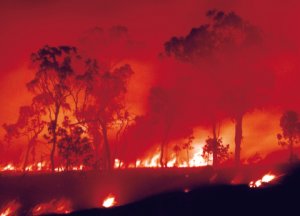Blog
A new era of fire
4 August 2010
First published in Eureka Street

Victoria’s Black Saturday (7 February 2009) was not a one-in-one-seventy-year event. While the main fire followed much the same trajectory as Black Friday 1939, it was not a repeat of that fire. Nor was it the result of ‘green’ policies that restricted hazard reduction burning, or of the incompetence of government or emergency services.
Black Saturday was a new phenomenon, a glimpse into the future. It was the first fire of the era of global warming and it was terrifying. No one had ever seen anything like its velocity and intensity. It resulted in new category of fire assessment: ‘catastrophic’.
So what were the new elements? As submissions to the Royal Commission by scientists like Professors Neville Nichols of Monash and Peter A. Gell of Ballarat University pointed out the answer is that south-eastern Australia is drying out and the most plausible cause is global warming. Victoria has had a 20 per cent drop in rainfall over the last 12 years. Recent summers have been the hottest and driest on record, way outside the normal range. As Professor Nichols told the Commission: ‘The gradual warming of Australian mean maximum temperature of about 0.75°C most likely … contributed to the extreme heat observed on [Black Saturday] … It seem unlikely that such new records, so far outside prior experience, would have occurred in the absence of gradual warming since about 1970.’
He also emphasised ‘the chronic Victorian rainfall decline over the past decade.’ The weather systems that brought rain to the south-east are shifting further south so that much of the rain now falls either over the ocean or western Tasmania. It is misleading to talk about a ‘drought’, because that implies that things will eventually return to ‘normal’. In fact, the present weather conditions are the new ‘normal’.
This will lead to bushfires that are more frequent and intense, of greater velocity and more widespread. No longer are Black Friday and Ash Wednesday the norms by which fires are judged; the new measure is Black Saturday. Psychologically this has left many people ‘gob smacked’. They are unable to comprehend what has happened, let alone think that Black Saturday might now be the norm for future bushfires.
Unfortunately the Royal Commission doesn’t seem to recognize this. The whole feel of its recommendations is business as usual. There is a lack of historical context and a failure to recognize that we have entered a new fire context. This is not to say that many of its recommendations are not useful; they are, but they lack this long-term frame of reference.
The Commission also fell into the trap of the blame game. This happens after every major fire and it originates in the need to find scapegoats and deal with a sense of grief and loss. Very badly led by counsel assisting the royal Commission, the victims of this were former Police Commissioner Christine Nixon, CFA chief Russell Rees, DSE fire officer Ewan Waller, and Emergency Services Commissioner Bruce Esplin. Sure, there were inadequacies in their performance, but they were unknowingly dealing with a whole new era of firestorm. No one could have predicted what was going to happen that Saturday.
Many of the Commission’s recommendations make sense. People can’t continue to live in the bush surrounded by trees, or along ridge lines, or at the top of escarpments. Governments either need to buy them out, or make it absolutely clear that fire fighters can’t risk their lives saving them and their property if they refuse to take an offer to move. However, Premier Brumby’s response was not encouraging. Aware of the cost of buying back of properties in high-risk areas, he questioned what impact this would have on towns. ‘What would that mean for the Dandenongs, for example?’ he asked.
Designated community refuges are an excellent idea and one wonders why they were not implemented years ago. Another is dug-outs or basic fire shelters that can be used as a last resort for those caught in a firestorm. The Commission also makes many good suggestions for the re-organization of fire and emergency responses.
One area of continued tension is what the Commission calls ‘Land and Fuel Management’, in other words ‘prescribed burning’. The Commission recommends that ‘The State fund and commit to implementing a long-term policy of prescribed burning based on an annual target of 5% minimum of public land’ and that the DSE ‘report annually on prescribed burning outcomes in a manner that meets public accountability objectives’.
For some prescribed burning has assumed the status of unchallengeable orthodox dogma. But in my view hazard reduction burning is becoming completely ineffective as global warming takes hold. Even when carried out with environmental sensitivity it still has inevitable impacts on native flora and fauna. However, the Commission’s response is quite conservative in comparison to the hysterical nonsense of columnists like Miranda Devine who told Sydney Morning Herald readers that it wasn’t arsonists or climate change that killed Black Saturday’s victims, but ‘the power of green ideology over government to reduce fuel hazards before a mega-fire erupts … It is not arsonists who should be hanging from lampposts but greenies’ (12/2/09).
Clearly challenging engrained public prejudice will never be easy.
Care to comment? .